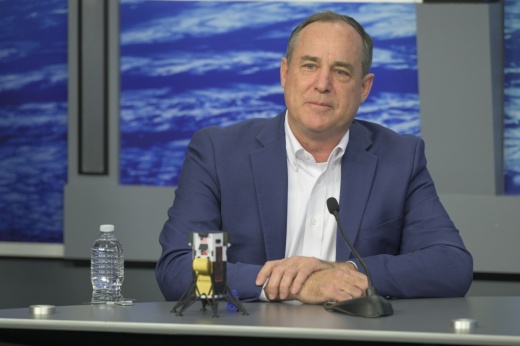Prior to the vessel shutting down, officials were concerned that the mission could end earlier than planned due to it being tilted over after its landing. In the week since, however, they have called it a success, and hope the vessel could wake back up once exposed to solar light again.
What you need to know
On Feb. 15, Houston-based aerospace company Intuitive Machines, with the help of aeronautics company SpaceX, NASA and several other government agencies, launched a payload toward the moon, which was designed to collect data and information from the lunar surface.
The goal, in addition to gathering more information, was to have the vessel act as a first step toward future missions to the moon and outer space. Those missions could take both future payloads, and eventually astronauts, to the moon’s south pole.
The landing, which took place Feb. 22, was the first time the U.S. had landed something on the moon in more than 50 years, according to a Feb. 28 news release from NASA.
Diving in deeper
While officials across the companies and agencies involved are hailing the landing as a success, it did not come without its hiccups or challenges, Intuitive Machines co-founder and CEO Steve Altemus said at a Feb. 28 press conference.
Among the various challenges of launching the vessel, named Odysseus, the one discussed the most at the press conference was the vessel slightly tipping over upon landing.
Odysseus, Altemus said, came in faster and at a higher elevation than was planned, which made the vessel land harder.
During the landing, Odysseus was giving off little to no signal, but indications showed it had landed upright, Altemus said. However, once communication came back online, readings suggested it was tipped over.
On the mission itself, which was centered around gathering data, every payload sent—both commercial and government—has received back some level of data, said Sue Lederer, commercial lunar payload services project scientist at NASA, at the Feb. 28 press conference.
Quote of note
“We’ve conducted a very successful mission to this point, and we expect to go to the completion of the mission as planned,” Altemus said. “This mission was intended as a scout and a pilot mission to go land on the surface, collect the data, and then the cold of night was going to take the lander, where it would sit quietly for the rest of time. We accomplished that.”
“The big goal was to land your equipment softly so you can get data from it after you land, and that was done successfully,” said Joel Kearns, deputy associate administrator for exploration at NASA, at the Feb. 28 press conference.
Stay tuned
Officials involved in the project said Odysseus powered off Feb. 22 and will stay asleep for a few weeks during the lunar night, Altemus said.
However, with temperatures potentially going as low as minus 250 degrees Celsius, questions remain as to whether the batteries in the vessel can withstand the temperatures, said Tim Crain, Intuitive Machines co-founder and chief technology officer, at the Feb. 28 press conference.
While officials believe Odysseus will power back on with the help of solar power, the batteries help it transmit data back to Earth, Altemus said.
The mission is also the first of several planned this year from Intuitive Machines, with future launches also expected to take payloads to the moon.





